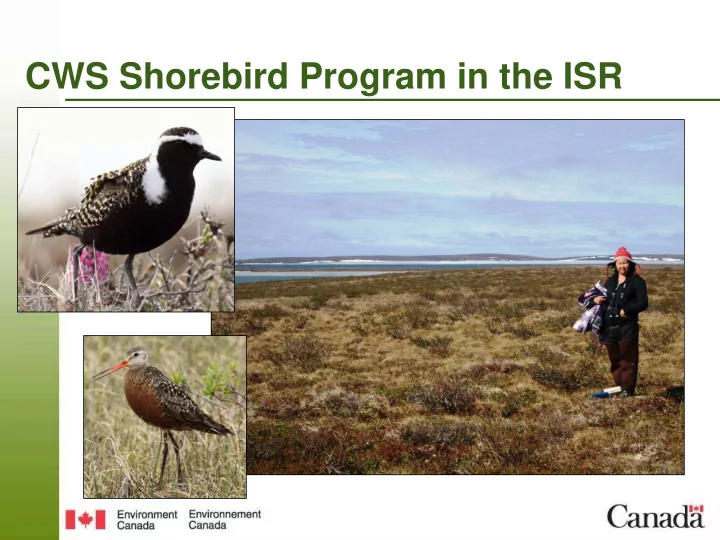

CWS Shorebird Program in the ISR
What is a shorebird? • Long pointed wings • Long legs and toes • Long bill • Smaller than goose • Larger than snow bunting or sparrow • Camouflaged feathers
What is a shorebird? • Migrate very far – from South America (or Europe) to Nunavut • Fly 40-60 hours at a time • Lay 4 eggs • Eat insects on tundra, invertebrates on migration
What Types of shorebirds? • Plovers – Chunky shorebirds, round heads, large eyes, shorter bills, quick runners, strong fliers, don’t like getting wet • Sandpipers – Largest family, long wings, long legs, long necks, small heads with long bills, quick runners, wade in water • Phalaropes – Very small shorebirds, small heads, needle-like bills, strong swimmers, females brighter coloured than males
What Shorebirds are in the ISR? • Lots and lots! The Mackenzie Delta is one of the best places in all of the Canadian North to see shorebirds Hudsonian Godwit Semipalmated Sandpiper Dunlin Red-necked Phalarope Stilt Sandpiper
So why the interest in Shorebirds? • ~ 75% of N. American shorebirds in decline • Variety of causes for declines • Pinpoint areas of decline, follow up with research and conservation action – how? • Arctic Program for Regional and International Shorebird Monitoring (Arctic PRISM)
Arctic PRISM Objectives • Estimate population size • Monitor trends in population size • Determine distribution, abundance, and habitats utilized throughout the year • Assist local managers in meeting shorebird conservation goals
Arctic PRISM Objectives Estimate population size Double sampling • Obtain arctic-wide habitat data and use to design stratified sampling plan •Large sample of plots surveyed using a rapid • Estimate shorebird densities on the plots – how? method •Subset intensively surveyed to estimate • Sum the estimates to obtain actual density and detection rates on the estimates of arctic-wide rapid surveys density and population size •Species-specific detection rate used to adjust results from rapid surveys
Arctic PRISM Objectives Monitor trends in population size • Tier 1 - Arctic Wide Surveys - won’t identify trends for several years • Tier 2 - Permanent Sites - East Bay Bird Sanctuary, NU - Kendall Island Bird Sanctuary, NT
Arctic PRISM Objectives Determine distribution, abundance, and habitats utilized throughout the year • Tier 3 - Checklist Program - NWT/Nunavut Bird Checklist Survey
Arctic PRISM Objectives Assist local managers with their conservation goals • For Mackenzie Valley Oil and Gas Project environmental assessment – Determine the distribution, habitat requirements, and population size of shorebirds in the Mackenzie Delta – Need to know what impact proposed MGP could have on shorebirds • Species at Risk
So what’s been going on in the ISR for shorebird monitoring? • Surveys from Yukon North Slope to Anderson River (2005-2009) • Emphasis on areas that may be affected by MGP , e.g. KIBS, Fish Island (2005-present)
What have we found? • There are ~1/2 million shorebirds of 14 different species nesting in the Mackenzie Delta (not changed since early 90s) • Whimbrel, Hudsonian Godwit and Long-billed Dowitchers have very few places where they nest, Mackenzie Delta is one of them
What have we found? • Niglintgak and Taglu (where O&G footprints will be) are shorebird ‘hot spots’ • Most productive area for nesting shorebirds is Fish Island • KIBS and the adjacent areas are very important for shorebirds
Special project: Whimbrel • Why study Whimbrel? – Negative population trend – Very restricted breeding range (centred on oil and gas development area) • What did we find? – Entirely in low-centred polygons (nest, feed, raise chicks) – Areas that are too shrubby or too dry nests aren’t successful
Special project: Red-necked Phalarope • Why study Red-necked Phalarope? – Most numerous species – Major declines on migration counts • What did we find? – Ponds are selected for social reasons – Concealed nests more successful
Involvement of Beneficiaries • Have had pleasure of working with 5 Inuvialuit youth since our shorebird project in the ISR began in 2005
So what’s the plan for shorebird monitoring from now on? • Continuing the same surveys WMAC and HTCs have supported since 2005, i.e. • Monitoring shorebird: – Populations – Nest success – Number of returning birds (banding) – Physical health (blood sampling)
Shorebird Information • For more information about shorebirds or shorebird monitoring in the ISR, contact Jennie Rausch at 867-669-4709 or jennie.rausch@ec.gc.ca
Recommend
More recommend